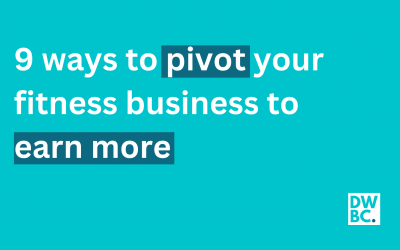SUMMARY: Time management is as a meta skill for fitness business success. There are three main ways Fitness Professionals spend their time: working in the business with billable hours, working in the business doing admin tasks, and working on the business to improve its efficiency, profitability, and future growth. We need to adjust the dials on each of these task types to optimise our business.
The most important thing for Fitness Business owners to manage is their time.
Not only can this improve your efficiency and output, but, probably more importantly, can help manage the feelings of being out of control or unable to keep your head above water – the general mental overwhelm that can come from being a business owner.
In fact, I’d go as far as to say that the ability to manage time is probably the most important meta skill we can have.
A meta skill is a higher-order skill that enables an us to acquire and apply other skills effectively. It’s something that can be applied across different areas of life, such as learning, problem-solving, and communication. Skills like this are often referred to as “learning to learn” skills or “thinking about thinking” skills.
A meta skill like time management isn’t specific to any particular field or domain but can be applied to a wide range of situations. A skill like this can improve our ability ability to learn, work effectively, and succeed in other aspects of our lives.
So let’s zoom back in on how we can better manage our time, and how this enables us to better manage our business and our life.
As of right now, I’ve run over 2,500 one-on-one Business Mentoring sessions for Fitness Professionals as part of Range of Motion Business Mentoring. A big part of these consultations involves us examining how we use time. Ideally, the pie chart of our business’s priorities should perfectly overlap with how we distribute our time.
But this is often not the case.
By talking with all these business owners, I’ve identified three main ways Fitness Professionals spend their time:
1) Working in the business with billable hours.
2) Working in the business doing admin tasks.
3) Working on the business.
Let’s unpack each of these, first by defining them, and then by exploring how they can be optimised to maximise business success by either increasing time spent on them, decreasing time spent on them, or changing how they’re done to maximise results. And then at the end, I’ll give you a fourth important use of your time in your business that I don’t see many people achieving, something that has the potential to drastically move the needle for your fitness business.
So first we’ve got time spent working in the business with billable hours. This is pretty simple for most fitness professionals, and includes any tasks that you’re directly paid for – where you can pair the number of minutes or hours you’re working with how much you get paid for that time. You might get paid $60 to run a group class, or $70 for a half hour PT session. And the relationship between time spent working and income received is generally fixed. And for Fitness Professionals, when we multiply hours worked by hourly rate, we generally come up with a pretty healthy number, which can make us think that we’re getting a really good financial return on the time we’re spending working.
But that’s not the complete picture, because we do a lot of work that we’re not directly paid for.
So let’s move on from the billable hours to time spent in the business doing admin tasks. These are the hidden tasks in your business. Following up on leads, programming, communicating with clients, checking and sending emails, receiving and making calls, traveling to work, and the thousand other tiny things that drain our time. But they need to be done. They’re imperative non-negotiables that must be done to keep your business with its head above water.
But of course we don’t just want to keep our head above water. Spending your life trying not to drown is a pretty exhausting way to run a business. And yet, the two uses of time we’ve discussed, working in the business with billable hours and working in the business doing admin tasks, are where the vast majority of Fitness Professionals spent at least 95% of their time. Before we move on to the next use of time, let’s talk about the elephant in the room, the common theme with what we’ve discussed so far. Both billable hours and admin tasks have one key word in common. ‘In’. Working IN the business with billable hours and working IN the business doing admin tasks. Any uses of time where you’re working in the business, are uses of time where you’re working to keep your head above water. Time spent struggling to hold your ground, not time spent moving forward.
So let’s move away from time spent IN the business, to the third major use of time for Fitness Professionals. Time spent working ON the business.
I call this a major use of time, but realistically, when I start working with fitness business people, it’s not a major use of time at all, but something that’s not done at all.
So what does ’working on the business’ look like? I like to define it by what it looks like, and what it does. Let’s start with what it looks like. It looks like ‘deep work’. Long, focused, uninterrupted blocks of time, often in a flow state where we’re so engrossed with a task that time passes without us being aware of it. For me, this means sitting in a booth in a cafe with my laptop, noise cancelling airpods in. That’s what it looks like.
So what does it do?
It improves my business. It’s not about preventing drowning, but about powerfully swimming forward to a better future for my business and my life. This time might be spent building systems that make working IN the business more efficient and profitable, it might be spent on marketing, it might be spent on content creation to make me an authority in a certain area, or it might be spent on building new income streams for my business. There’s a common theme here – which leads to a question I ask myself at the end of every period of deep work. The common theme is that working ON the business increases the value and income generating capacity of the business. And the question I ask myself? ‘If I was to sell my business at the end of a period of deep work, would I get more for it than I would have at the start of that period of deep work?’.
If the answer is yes, then you can rest assured that you were working ON, not IN your business.
So there are our three main uses of time.
1) Working in the business with billable hours.
2) Working in the business doing admin tasks.
3) Working on the business.
Now let’s optimise. Let’s tweak the dials on each of these three main uses of time.
Firstly ‘working in the business with billable hours’. Our priority here should be to increase our hourly rate, to earn more for every minute or hour worked. And as part of this, we should reduce the total hours we work, or at least earn ourselves the choice and freedom to do this. Ultimately, we want more money for less time – nothing groundbreaking there.
Next, ‘working in the business doing admin tasks. For this use of time, we want to build systems to automate the tasks in this category as much as possible. There is no direct financial return for the hours we spend on admin tasks, so we obviously want to turn the dial down here. The asterisk on this is that no one should be able to tell we’re spending less time on admin. The whole point of systemisation is to be able to automate processes so they are still done as well as, or actually probably better than they would be if you were grinding through each individual step yourself.
And finally, working in the business. We want to turn this dial right up to ten. Remember, these are the tasks that increase the size of the asset that is our business. Not only that, but by having time for big blocks of deep, focussed work, we can optimise the other two big uses of our time. We can build a business with a high hourly rate and systemised admin tasks.
So let’s summarise. We want to work less billable hours in the business at a higher hourly rate; we want to work less admin hours by automating; and we want to work more ON our business.
If you can achieve this, two things happen in the long term. You have more time to spend doing the things outside your business that enrich your life, and you have time to unlock the fourth potential use of time within your business that I hinted at before.
You unlock the freedom to diversify. If you’ve optimised the three biggest uses of your time, your next step should be to allocate a well defined silo of time each week to pursue the shiny ideas that would normally be a distraction to your business. Those brainwaves you have in the shower. The things that aren’t really contributing to your current business focuses, but that you just can’t stop thinking about. Carve out two hours in your calendar each week. That’s the time – the only time – that you’re allowed to be working on these exciting new projects and side hustles. You want to build fast and fail fast here. Build a minimal viable product for your idea, put it out into the word and see if you get any bites. If you don’t, move on. If you do, you can move the work from the two hour silo into your ‘working on the business’ deep work. The aim should be to fail fast and often. Maybe one out of 50 ideas you have will turn out to be a run away business success. If it takes you 50 weeks to market-test 50 ideas, you’ll have one game changing new opportunity every year. If it takes you 50 years to market-test 50 ideas, you’ll be lucky to get one success in your lifetime.
Management of your time is key to your business success. The take-away for you is to bring your awareness to how and where you time is being spent, and put steps in place to increase your hourly rate, systemise your processes, and move yourself into the CEO role where you can build a vehicle to optimise your business and your life.





